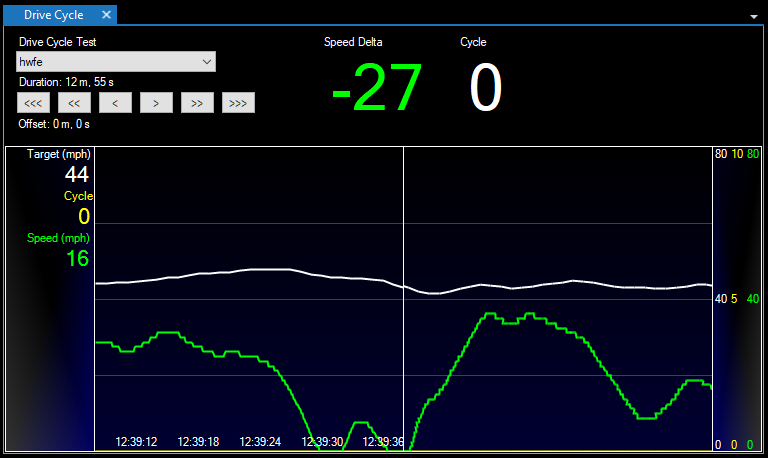Drive Cycle Panel
NOTE: This feature requires VCM Suite version 4.13 (or later).
Drive cycles are standardized driving patterns used for testing emissions and fuel economy. The Drive Cycle panel provides guidance for the driver when attempting to perform one of these tests. Performing a standardized drive cycle can be useful when:
|
■
|
Ensuring that emissions and fuel economy testing of your build complies with national and/or local regulation. |
|
■
|
If you have recently cleared DTCs, disconnected the vehicle battery, or performed other major maintenance, the on board emissions monitors will reset and may take several drive cycles to complete their testing. Vehicles will not pass emissions testing until these on board tests are completed. Following a standardized driving cycle helps to ensure that this testing is completed as quickly as possible. |
Performing a Drive Cycle
Completing a drive cycle requires that the driver accelerate to specific speeds (or above) and then maintain those speeds for several minutes. Typically, the driver will then be required to decelerate or stop and then accelerate to a specified speed multiple times.
It is recommended that you begin the test with a relatively cold engine and proceed immediately to an open highway with little to no traffic so that you can accelerate and decelerate without worrying about surrounding vehicles.
|
1.
|
Connect your HP Tuners interface device to your laptop and then connect the interface to the OBD-II port on the vehicle to be tested. See Connecting to a Vehicle for details. |
|
2.
|
If VCM Editor is open, close it now. |
|
4.
|
Open a layout that includes a Drive Cycle panel. |
|
5.
|
In the Drive Cycle Test dropdown, select the test that you wish to complete. |
|
6.
|
Turn the vehicle ignition ON. |
|
7.
|
Click the  icon in the toolbar to open a data connection to the vehicle. icon in the toolbar to open a data connection to the vehicle. |
|
8.
|
When the vehicle is in position to begin the test, click  to start scanning. to start scanning. |
|
9.
|
The white line on the Drive Cycle panel will indicate a target speed. Accelerate to the target speed. The green line will indicate the current speed of your vehicle. |
|
10.
|
Continue following the white line for guidance until the drive has been completed. |
NOTE: After the drive cycle, you can check to see if the vehicle's emissions monitors have completed their self testing in the Diagnostics & Information window. See Checking Emissions Monitor Status for details.


